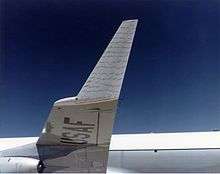Tuft (aeronautics)
| Look up tuft (aeronautics) in Wiktionary, the free dictionary. |
This article is about tufts in aeronautics. For tufting in textiles, see Tufting. For tufting in the composite materials field, see Tufting (composites).

A winglet on a KC-135 Stratotanker with attached tufts showing airflow during NASA tests in 1979–80.
In aviation, tufts are strips of yarn or string, typically around 15 cm (6 in), attached to an aircraft surface in a grid pattern and imaged during flight. The motion of the tufts during flight can be observed and recorded, to locate flow features such as boundary layer separation and reattachment. Tufting is, therefore, a technique for flow visualization. They are used in aeronautics flight testing to study air flow direction, strength, and boundary layer properties.
The world's largest bed of tufts (18.6 m by 18.6 m, 61 feet by 61 feet) was created at NASA Ames Research Center to study air flow fields involving a helicopter's rotor disk.[1]
See also
References
- ↑ Prouty, Ray (1 January 2009). "Helicopter Aerodynamics Volume II". Lulu.com. Retrieved 19 October 2016 – via Google Books.
This article is issued from Wikipedia - version of the 10/19/2016. The text is available under the Creative Commons Attribution/Share Alike but additional terms may apply for the media files.